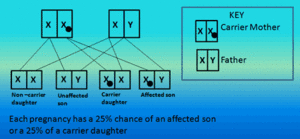Patterns of X-Linked Inheritance
Genes carried on the X chromosome are referred to as being X-linked while genes carried on the Y chromosome are referred to as exhibiting Y-linked or holandric inheritance.
X-linked Recessive Inheritance[edit | edit source]
An X-linked recessive trait is one determined by a gene carried on the X-chromosome and usually only manifests in males. Disease inherited in an X-linked manner are transmitted by healthy heterozygous female carriers to affected males, as well as by affected males to their obligate carrier daughters with a consequent risk to male grandchildren through these daughters.
Females with an affected son and an affected brother or with two affected sons must be heterozygous. They are obligate heterozygotes. Those who may or may not be heterozygous are facultative heterozygotes.
Genetic Risks[edit | edit source]
A male transmits his X chromosome to each of his daughters and his Y chromosome to each of his sons. If a male affected with haemophilia (an X-linked recessive disease) has children with a normal female, then all his daughters will be obligate carriers but none of his sons will be affected. A male cannot transmit an X linked trait to his son, with a very rare exception of uniparental heterdisomy.
For a carrier female of an X-linked recessive disorder having children with a normal male, each son has a 1 in 2 (50%) chance of being affected and each daughter has a 1 in 2 (50%) chance of being a carrier.
Duchenne muscular dystrophy is the commonest form of muscular dystrophy and is a severe disease. By about the age of ten affected boys can no longer walk and require a wheelchair. The muscle weakness gradually progresses and affected males ultimately become confined to bed and will often die before reaching the age of 20 years. Since affected boys do not usually survive to reproduce the disease is almost entirely transmitted by healthy female carriers.
Females affected with X-linked recessive disorders[edit | edit source]
Very rarely a woman can exhibit an X-linked recessive trait and there are several explanations as to how this can happen.
Homozygosity: Another example of an X-linked recessive trait is red-green colour blindness. About 8% of males are red-green colour blind and about 1 in 150 women are red-green colour blind. A female could be a homozygote because her mother was a carrier and her father was affected, or because her father was affected and her mother was normal but a new mutation occurred on the X chromosome transmitted to the daughter.
Skewed X-inactivation: The process of X-inactivation usually occurs randomly so by chance in a heterozygous carrier female the active X chromosome in most of her cells could be the one bearing the mutant allele. If this happens a carrier female would exhibit some of the symptoms and signs of the disease and is known as manifesting heterozygote or carrier.
Numerical X-chromosome abnormalities: A female could manifest a disorder through being a carrier of an X-linked recessive mutation and having only a single X chromosome i.e. Turner’s syndrome.
X-autosome translocations: Females with a translocation involving one of the X chromosomes and an autosome can be affected.
X-linked Dominant Inheritance[edit | edit source]
It is uncommon and superficially resembles that of an autosomal dominant trait because both sons and daughters of an affected female have a 50% chance of being affected. There is an important difference, an affected male transmits the trait to all of his daughters but to none of his sons. Therefore in families with X-linked dominant disorders there is an excess of affected females and direct male to male transmission cannot occur. An example is vitamin D-resistant rickets.
Establishing Mode of Inheritance[edit | edit source]
X-linked recessive:[edit | edit source]
- Affects males almost exclusively
- Transmitted through unaffected carrier females to their sons
- Male to male transmission is not observed.
X-linked dominant:[edit | edit source]
- Males and females are affected, but affected females are more frequent
- Females are usually less severely affected than males
- Affected females can transmit the disorder to both male and female offspring, affected males can only transmit the disorder to their daughters all of whom will be affected.
The proportion of new mutations in X chromosomal inheritance is relatively high. The reason is that males affected with a severe X chromosomal disease cannot reproduce to transmit the mutation to their offspring. Since one third of the X chromosomes in the population are present in males and since a severe X chromosomal disease is incompatible with reproduction, these male-carried Xs will be eliminated from the population. However their mutations will be replaced by new mutations. Therefore, one third of males with severe X chromosomal disorders without a family history have a new mutation (Haldane’s rule).
Related Articles[edit | edit source]
http://en.wikipedia.org/wiki/X-linked_recessive_inheritance
http://en.wikipedia.org/wiki/X-linked_dominant_inheritance
Bibliography[edit | edit source]
Mueller, R F. Young, I D. (2001). Emery's Elements of Medical Genetics.
Passarge, Eberhard (2013). Color Atlas of Genetics.



